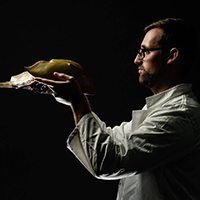 Russell D.C. Bicknell. Palaeoscience Research Centre, School of Environmental and Rural Science, University of New England, Armidale, 2351, Australia. Corresponding author rdcbicknell@gmail.com
Russell D.C. Bicknell. Palaeoscience Research Centre, School of Environmental and Rural Science, University of New England, Armidale, 2351, Australia. Corresponding author rdcbicknell@gmail.com
Russell D.C. Bicknell is a post-doctoral researcher at the University of New England, Australia. While interested in an array of palaeontological topics, he has dedicated a large portion of his research thus far to horseshoe crabs and related chelicerate groups. He is particularly passionate about combining traditional systematic palaeontology with geometric morphometric analyses to uncover evolutionary patterns.
![]()
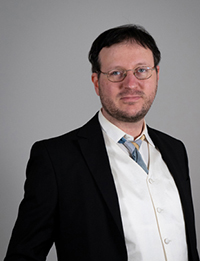 Jure Žalohar. T-TECTO, Koroška cesta 12, SI-4000 Kranj, Slovenia. jure.zalohar@guest.arnes.si
Jure Žalohar. T-TECTO, Koroška cesta 12, SI-4000 Kranj, Slovenia. jure.zalohar@guest.arnes.si
Dr. Jure Žalohar is a physicist and geologist. He is a co-founder and co-owner of Quantectum AG, a Swiss-based company dedicated to advancing earthquake forecasting. He obtained his Ph.D. from the University of Ljubljana in 2008. Dr. Žalohar’s main research fields are physics of faults and earthquakes, seismology, stratigraphy, and paleontology. Among his most important achievements are a series of articles on the Cosserat mechanics of faulting for the Journal of Structural Geology and the development of the T-TECTO software for fault-slip data and earthquakes analysis, which is now recognized and used by structural geologists around the world. During numerous field trips observing tectonic structures in the Alps, he and his colleagues made important paleontological discoveries, including identifying the oldest and only-known fossils of seahorses, pipehorses and pygmy pipehorses, new fossil sites with complete skeletons of Triassic reptilians, fishes, and other biotas from the Tethys Ocean. His most important contribution to science is the discovery of a new physical theory of earthquakes that brings a redefinition and solution to the earthquake prediction problem. In the last few years, he develops and tests the Quantectum Earthquake Forecasting System, which allows for time-dependent earthquake forecasts and predictions based on the Omega-Theory.
![]()
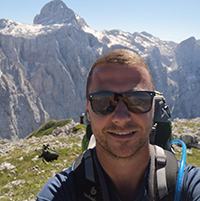 Primož Miklavc. Department of Geology, Faculty of Natural Sciences and Engineering, University of Ljubljana, Aškerčeva ceta 12, SI-1000 Ljubljana, Slovenia. primoz.miklavc@gmail.com
Primož Miklavc. Department of Geology, Faculty of Natural Sciences and Engineering, University of Ljubljana, Aškerčeva ceta 12, SI-1000 Ljubljana, Slovenia. primoz.miklavc@gmail.com
Primož Miklavc is a laboratory technician in the Department of Geology (Faculty of Natural Sciences, Ljubljana). His expertise falls withinn thin section preparation and granulometric analyses. In addition, he also finds time and energy for research on the side. His main research areas of interest are stratigraphy and sedimentology. He is particularly interested in the Triassic evolution of the Kamnik-Savinja Alps and recently also in the sedimentological characteristics of clastic cave sediments.
![]()
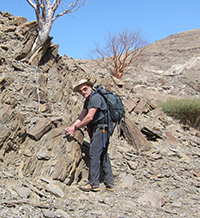 Bogomir Celarc. Geological Survey of Slovenia, Dimičeva ulica 14, SI-1000 Ljubljana, Slovenia.
Bogomir Celarc. Geological Survey of Slovenia, Dimičeva ulica 14, SI-1000 Ljubljana, Slovenia.
Dr. Bogomir Celarc was a regional geologist from Geological Survey of Slovenia. Besides geological mapping, his main research interest was Triassic sequence stratigraphy of the Slovenian Alps. He was dealing predominantly with dynamics of the carbonate platforms progradation and its relationship with basinal sequences. Other research interests included Triassic paleogeographic reconstructions and structural geology.
![]()
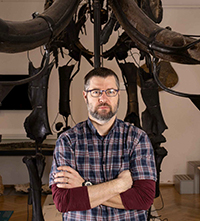 Matija Križnar. Slovenian Museum of Natural History, Prešernova 20, SI-1000 Ljubljana, Slovenia. mkriznar@pms-lj.si
Matija Križnar. Slovenian Museum of Natural History, Prešernova 20, SI-1000 Ljubljana, Slovenia. mkriznar@pms-lj.si
Matija Križnar is a museum curator (for Paleontological Collections) and researcher at the Slovenian Museum of Natural History. His general paleontological research is focused on fossils from Slovenia territory. Being a paleontologist with a strong interest mostly on the fossil vertebrates, ammonites and trilobites, as well as the history of Slovenian paleontology and geology.
![]()
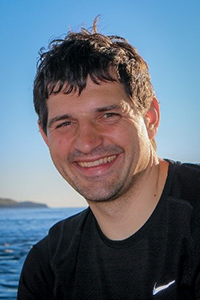 Tomaž Hitij. Dental School, Faculty of Medicine, University of Ljubljana, Hrvatski trg 6, SI-1000 Ljubljana, Slovenia. tomazhitij@gmail.com
Tomaž Hitij. Dental School, Faculty of Medicine, University of Ljubljana, Hrvatski trg 6, SI-1000 Ljubljana, Slovenia. tomazhitij@gmail.com
Tomaž Hitij is an assistant professor in dental school and endodontist by day and “amateur” paleontologist by night and on weekends. He has discovered many of the most important Slovenian paleontological sites and described many of his fossil finds. With Jure Žalohar he collected a large vertebrate and arthropod fossils collection ranging in age from Triassic to Pleistocene from across Slovenia. He is also a passionate fossil preparator. His research interests revolve around Triassic stratigraphy of the Kamnik-Savinja Alps and vertebrate taphonomy; however, his main interests are fossil vertebrates and arthropods.

